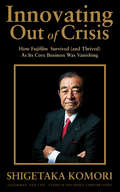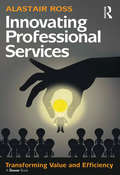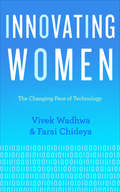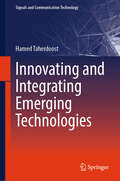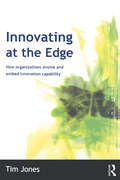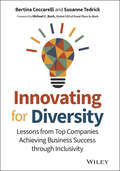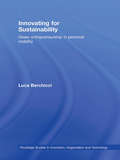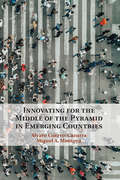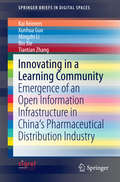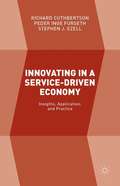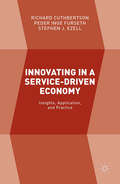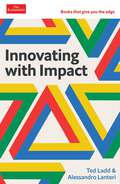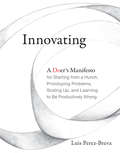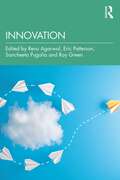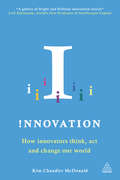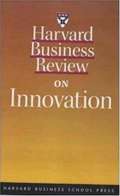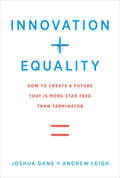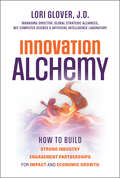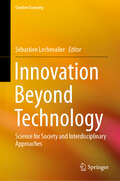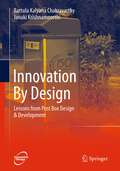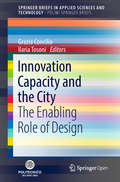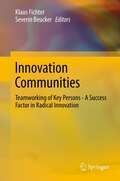- Table View
- List View
Innovating Out of Crisis
by Shigetaka KomoriIn 2000, photographic film products made up 60% of Fujifilm's sales and up to 70% of its profit. Within ten years, digital cameras had destroyed that business. In 2012, Kodak filed for bankruptcy. Yet Fujifilm has boasted record profits and continues strong. What happened? What did Fujifilm do? What do businesses today need from their leaders? What kinds of employees can help businesses thrive in the future? Here, the CEO who brought Fujifilm back from the brink explains how he engineered transformative organizational innovation and product diversification, with observations on his management philosophy.Shigetaka Komori is Chairman and CEO of Fujifilm Holdings Corporation. Mr. Komori was appointed CEO in 2003 and chairman in 2012.
Innovating Professional Services: Transforming Value and Efficiency
by Alastair RossInnovating Professional Services provides a practical and detailed guide for change agents and leaders in professional service firms who are seeking to transform their firm’s performance through innovation. The book covers business innovation in its broadest sense as it is relevant to the professional services sector. This includes process innovation - the re-engineering of services and internal support processes to reduce cost and increase value to clients. It also includes the development of new services, market-position innovation and also business model innovation. Alastair Ross draws heavily on his practical experience in working with leading law firms and business service and consulting firms over the past ten years in which he and his firm have applied best practice techniques and methods to create measurable improvements. Detailed techniques such as the use of Lean, process mapping, waste identification, service experience mapping and value profiling are explained. The book also details effective approaches for making the required changes in professional service firms. Multiple case studies are used to help demonstrate the opportunities - and challenges - of driving major improvement through innovation. The book can be used by leaders and change agents in law firms, accountants, consultants, architects, financial services and engineering services, to explore the opportunities for innovation in their firms and then to construct and implement a transformation programme to embed innovation in their organisations.
Innovating Women: The Changing Face of Technology
by Farai Chideya Vivek WadhwaFrom one of Time Magazine's 40 Most Influential Minds in Technology: women across the globe share stories of closing the tech industry&’s gender gap. Women in technology are on the rise in both power and numbers, but we need to accelerate that momentum if we want to "lean in" and close the gender gap. The future of technology depends on women and men working together at their full potential. For that to happen, it is vital that women feel welcomed, rewarded, and respected in tech sectors. Hailed by Foreign Policy Magazine as a &“Top 100 Global Thinker,&” professor, researcher, and entrepreneur Vivek Wadhwa, alongside award-winning journalist Farai Chideya, collect anecdotes and essays from female tech leaders around the world, sharing how their experiences in innovative industries frame the future of entrepreneurship. With interviews and essays from hundreds of women in STEM fields, including Anousheh Ansari, the first female private sector space explorer; former Google[X] VP and current CTO of the USA, Megan Smith; Ory Okolloh of the Omidyar Network; CEO of Nanobiosym Dr. Anita Goel, MD, PhD,; and venture capitalist Heidi Roizen, Innovating Women offers perspectives on the challenges that women face, the strategies that they employ in the workplace, and how organizations can support the career advancement of women.
Innovating and Integrating Emerging Technologies (Signals and Communication Technology)
by Hamed TaherdoostThis book explores all aspects of innovation, including funding, business strategies, and real-world uses for game-changing technologies like blockchain, IoT, AI, and big data. Learn about the fundamentals of cloud computing, explore the moral implications of virtual reality, comprehend the complexities of quantum computing, and explore the domains of robotics, 3D printing, and 6G technology. The book covers each technology's foundations, uses, and future developments. The author makes complicated subjects easier to understand by using reader-friendly language, tables, and graphics. The intricacies of these technologies will become clear to readers, enabling them to capitalize on innovation's promise for both career and personal growth. Explores emerging technologies from blockchain and AI to 3D printing and smart cities; Integrates business, ethics, social impacts, and regulatory considerations into discussions of innovation; Combines practical experience with trustworthy and valuable insights for readers at all levels of expertise.
Innovating at the Edge: How Organizations Evolve And Embed Innovation Capability
by Tim JonesAll organizations who are looking to improve performance through embracing new ideas, work in new ways, create new products and services, challenge the status quo or redefine their existing business environment have much to gain from this book. 'Innovating at the Edge' not only provides readers with an informed understanding of the latest developments in innovation practice but also presents them with the bigger picture. This enables them to determine how to build these advances into overall development of their own innovation capabilities and how to capitalize on the benefits available to them. Today as the new economy is brought into line with the old, increasing fragmentation of a global economy drives change across multiple sectors. Organizations operating at the leading edge of the innovation paradigm are adopting a whole new set of approaches to help them redefine the present and build the future. Learn how companies such as Egg, Dyson and Smint are redefining their markets, how organizations such as ARM and Qualcomm are deriving their soaring revenues wholly from licensing, and how firms such as Nokia and Nike are constantly evolving their product portfolios and associated value propositions. These real-life examples provide key lessons for all involved in creating and delivering new businesses, products and services. Readers will understand where all these strands fit within an overall context of innovation evolution, and recognise that the inter-relationships between strategy, process and organization are the key enablers for achieving innovation improvements. Firms can then grasp and appreciate what they need to do in order to emulate these innovation leaders operating at the edge of contemporary practice.
Innovating for Diversity: Lessons from Top Companies Achieving Business Success through Inclusivity
by Susanne Tedrick Bertina CeccarelliDiscover what business visionaries on the frontiers of diverse and equitable hiring are doing to drive change in their organizations In Innovating for Diversity: Lessons from Top Companies That are Disrupting Old Practices to Achieve Inclusivity, Equity and Business Success, renowned Diversity, Equity, and Inclusion (DEI) and tech specialists Bertina Ceccarelli and Susanne Tedrick reframe the DEI discussion and move it beyond a human resources issue. While it's well established that diverse teams help to advance innovation, the authors explain how principles of innovation can be applied to building highly effective and sustainable diversity, equity and inclusion (DEI) practices embraced by executives across an organization. You'll be inspired by leaders at top companies who identified root causes of limited DEI progress and created smart, bold solutions for increasing representation, developing future talent, and advancing the careers of people often overlooked. In the book, you'll also find: Introductions to the people and companies who have innovated their approaches to diverse hiring, retention, and advancement, and enjoyed pronounced impact on their bottom lines Profiles of committed leaders driving the change towards a more diverse and inclusive workforce Strategies for breaking down the cultural and organizational barriers in companies that remain in place and prevent transformative change A critical resource for senior-level business professionals, managers, and executives, Innovating for Diversity will also prove to be invaluable for people seeking to build their careers from the ground up.
Innovating for Sustainability: Green Entrepreneurship in Personal Mobility (Routledge Studies in Innovation, Organizations and Technology)
by Luca BerchicciOne of the challenges met by green entrepreneurs and product developers who have tried to develop more sustainable products is that efforts to have better products in environmental terms do not always translate into effective business cases. The purpose of this book is a better understanding of the implications of environmental issues in new product development. Through an empirical study in the human powered vehicle sector, Luca Berchicci examines how and to what extent the environmental ambition of product developers and managers influences the way new products and services are developed. The understanding of this phenomenon is particularly important since managers are encouraged and/or motivated to undertake environmental new product development projects. From the descriptions and analyses of the two cases study Luca Berchicci suggests that a high level of environmental ambition increases the complexity of the product innovation process. Moreover, a high level of environmental ambition may hamper a product innovation process because it may lead the developers away from the market that their product is to serve. Accordingly, this book attempts to explain and predict how environmental ambition influences new product development processes. This claim provides a theoretical contribution to existing research in both product innovation and green product innovation. Moreover, this book provides an original and deep insight on the diverse facets of greening.
Innovating for the Global South
by Janice Gross Stein Joseph Wong Dilip SomanDespite the vast wealth generated in the last half century, in today's world inequality is worsening and poverty is becoming increasingly chronic. Hundreds of millions of people continue to live on less than $2 per day and lack basic human necessities such as nutritious food, shelter, clean water, primary health care, and education.Innovating for the Global South offers fresh solutions for reducing poverty in the developing world. Highlighting the multidisciplinary expertise of the University of Toronto's Global Innovation Group, leading experts from the fields of engineering, medicine, management, and global public policy examine the causes and consequences of endemic poverty and the challenges of mitigating its effects from the perspective of the world's poorest of the poor.Can we imagine ways to generate solar energy to run essential medical equipment in the countryside? Can we adapt information and communication technologies to provide up-to-the-minute agricultural market prices for remote farming villages? How do we create more inclusive innovation processes to hear the voices of those living in urban slums? Is it possible to reinvent a low-cost toilet that operates beyond the water and electricity grids?Motivated by the imperatives of developing, delivering, and harnessing innovation in the developing world, Innovating for the Global South is essential reading for managers, practitioners, and scholars of development, business, and policy.
Innovating for the Middle of the Pyramid in Emerging Countries
by Alvaro Cuervo-Cazurra Miguel A. MontoyaThe transformation of emerging markets in recent decades has generated a new, growing, and very large middle class market, also known as the middle of the pyramid. This market segment, which is middle by the standards of emerging markets yet low by the standards of advanced economies, is extremely attractive for firms, but still understood and underserved. This volume presents detailed analyses of exemplary firms that have innovated products, services, and business models to fulfil the needs and desires of these new middle classes. It provides useful insights for managers, consultants, researchers, and students interested in emerging economies, and actionable lessons on how to innovate for a new and expanding market segment.
Innovating in Urban Economies
by David A. WolfeIn a globalizing, knowledge-based economy, innovation and creative capacity lead to economic prosperity. Starting in 2006, the Innovation Systems Research Network began a six year-long study on how city-regions in Canada were surviving and thriving in a globalized world. That study resulted in the "Innovation, Creativity, and Governance in Canadian City-Regions" series, which examines the impact of innovation, talent, and institutions on sixteen city-regions across Canada. This volume explores how the social dynamics that influence innovation and knowledge flows in Canadian city-regions contribute to transformation and long-term growth.With case studies examining cities of all sizes, from Toronto to Moncton, Innovating in Urban Economies analyzes the impact of size, location, and the regional economy on innovation and knowledge in Canada's cities.
Innovating in a Learning Community
by Kai Reimers Xunhua Guo Mingzhi Li Bin Xie Tiantian ZhangHow do firms jointly develop open information infrastructures? To answer this question, this book draws on the results of a longitudinal research project covering the development of the pharmaceutical distribution industry in China from 2004 to 2012, focusing on the emergence and subsequent evolution of industry-wide information infrastructures. How do firms delimit areas of proprietary innovation in open innovation projects? How do firms coordinate, initiate, negotiate and implement the development of innovative infrastructures? How do processes and practices within firms enable and constrain such collective efforts? - This book provides answers to these questions and draws conclusions regarding the challenges and new capabilities that firms will need in a world in which participation in the building of open information infrastructures becomes a necessary task for commercial organizations.
Innovating in a Service-Driven Economy: Insights, Application, and Practice
by Richard Cuthbertson Peder Inge Furseth Stephen J. EzellInnovating in a Service-Driven Economy.
Innovating in a Service-Driven Economy: Insights, Application, and Practice
by Richard Cuthbertson Stephen J. Ezell Peder Inge FursethThe global digital revolution has changed consumer society, service expectations, and funding models forever. Value Driven Service Innovation explores these changes from the perspectives of leading thinkers and practitioners in the field of innovation today.
Innovating with Impact: The Economist Edge Series (The Economist Edge Series)
by Alessandro Lanteri Ted LaddWe're all innovators now. Thinkers and entrepreneurs Ted Ladd and Alessandro Lanteri show us how to make the most of our ideas.It is a myth to consider innovation the domain of the special few who are inspired by "eureka!" moments that always result in brilliant new products. In reality, anyone with the right tools, traits, and methods has the potential to innovate with impact, generating profits and even changing the world. In this engaging guide, top thinkers and entrepreneurs Ted Ladd and Alessandro Lanteri show how to create innovations that deliver customer value. Their Innovation Pyramid outlines a strategic process that is rooted in the right cultures and mindsets and uses a range of methods, techniques and themes to reach the pinnacle of maximum impact. Throughout the book, stories and examples from different organisations and contexts bring the text to life. This book is essential reading for anyone who wants to create, innovate, improve performance, and ultimately, make a difference.
Innovating: A Doer's Manifesto for Starting from a Hunch, Prototyping Problems, Scaling Up, and Learning to Be Productively Wrong
by Luis Perez-BrevaDiscover the MIT-developed, &“doer&’s approach&” to innovation with this guide that reveals you don&’t need an earth-shattering idea to create a standout product, service, or business—just a hunch that you can scale up to impact. Innovation is the subject of countless books and courses, but there&’s very little out there about how you actually innovate. Innovation and entrepreneurship are not one and the same, although aspiring innovators often think of them that way. They are told to get an idea and a team and to build a show-and-tell for potential investors. In Innovating, Luis Perez-Breva describes another approach—a doer&’s approach developed over a decade at MIT and internationally in workshops, classes, and companies. He shows that innovating doesn&’t require an earth-shattering idea; all it takes is a hunch. Anyone can do it. By prototyping a problem and learning by being wrong, innovating can be scaled up to make an impact. As Perez-Breva demonstrates, &“nothing is new&” at the outset of what we only later celebrate as innovation. In Innovating, the process—illustrated by unique and dynamic artwork—is shown to be empirical, experimental, nonlinear, and incremental. You give your hunch the structure of a problem. Anything can be a part. Your innovating accrues other people&’s knowledge and skills. Perez-Breva describes how to create a kit for innovating, and outlines questions that will help you think in new ways. Finally, he shows how to systematize what you&’ve learned: to advocate, communicate, scale up, manage innovating continuously, and document—&“you need a notebook to converse with yourself,&” he advises. Everyone interested in innovating also needs to read this book.
Innovation
by Renu Agarwal Roy Green Eric Patterson Sancheeta PugaliaIn recent years, a great deal of attention has been focussed on the undertaking of managing innovation. Without the right focus, resourcing and capabilities, firms struggle to create value through innovation. However, the task of managing innovation is one of continuous paradoxes where an overly structured mind-set can impede entrepreneurship, creativity, culture and the right conditions for disruption. The question remains of how we can have the right lens to properly understand and appreciate innovation, and how we can have a flexible set of tools, techniques and perspectives to support innovation. This concise text introduces readers to one of the fundamental ideas in the business world. Insights into the key ingredients of innovation, including business models, services, entrepreneurship and creativity are analysed alongside core contexts, such as disruptive technology. Students of business and management will appreciate additional coverage of the future of the field, including open innovation and the dark side of digital disruption. This accessible book provides a thought-provoking, stimulating perspective that will make it a valuable resource for a range of academic and student audiences across business and management disciplines.
Innovation
by Kim Chandler McdonaldAny organisation looking to succeed in the global digital economy of today - and tomorrow - must innovate. !nnovation introduces the global pioneers whose ideas and products have driven the changes that have revolutionised our world in every field. It showcases the pioneers who have broken the mould and led the pack in every field from business and technology to food, fashion, culture and healthcare. Drawing on exclusive interviews with more than 100 leading innovators from around the world, !nnovation highlights the common denominators linking these highly creative people. It presents the inside track on who's done what, how they did it, what drives them on, and why innovation is so critical to individuals, businesses and to society as a whole. This book is a fascinating, fast-paced read and more importantly, it will empower you and your business to be more innovative too.
Innovation + Equality: How to Create a Future That Is More Star Trek Than Terminator (The\mit Press Ser.)
by Joshua Gans Andrew LeighHow to get more innovation and more equality.Is economic inequality the price we pay for innovation? The amazing technological advances of the last two decades—in such areas as artificial intelligence, genetics, and materials—have benefited society collectively and rewarded innovators handsomely: we get cool smartphones and technology moguls become billionaires. This contributes to a growing wealth gap; in the United States; the wealth controlled by the top 0.1 percent of households equals that of the bottom ninety percent. Is this the inevitable cost of an innovation-driven economy? Economist Joshua Gans and policy maker Andrew Leigh make the case that pursuing innovation does not mean giving up on equality—precisely the opposite. In this book, they outline ways that society can become both more entrepreneurial and more egalitarian. All innovation entails uncertainty; there's no way to predict which new technologies will catch on. Therefore, Gans and Leigh argue, rather than betting on the future of particular professions, we should consider policies that embrace uncertainty and protect people from unfavorable outcomes. To this end, they suggest policies that promote both innovation and equality. If we encourage innovation in the right way, our future can look more like the cheerful techno-utopia of Star Trek than the dark techno-dystopia of The Terminator.
Innovation Alchemy: How to Build Strong Industry Engagement Partnerships for Impact and Economic Growth
by Lori GloverAn incisive and comprehensive new playbook for symbiotic partnerships In Innovation Alchemy: Building Strong Industry Engagement Partnerships for Impact and Economic Growth, leader of Global Partnerships and Alliances at MIT's Computer Science and Artificial Intelligence Lab, Lori Glover, delivers a compelling exploration of how to create mutually beneficial partnerships and collaborations in and between industry, academia, and beyond. You'll learn how to navigate, structure, and deliver win-win programs and take full advantage of research, faculty connections, new tech, student connections, professional development, capstones, course connections, technology transfer, and start-ups. Avoiding a “one-size-fits-all” approach, this book clarifies the foundations of solid partnerships and collaborations. It explains the author's 10 Steps to successful partnerships, including: How to understand the fundamentals and define your strategy Knowing your stakeholders and mapping their connection points Understanding possible paths of engagement, plan creation, and team building Innovation Alchemy offers checklists and tools to help you construct your own partnership plan and a complete roadmap for putting one into practice. It's an essential read for academic and industry leaders interested in unlocking the many benefits that flow from collaborations packed with case studies, leader interviews, toolkits, and additional resources.
Innovation Beyond Technology: Science for Society and Interdisciplinary Approaches (Creative Economy)
by Sébastien LechevalierThe major purpose of this book is to clarify the importance of non-technological factors in innovation to cope with contemporary complex societal issues while critically reconsidering the relations between science, technology, innovation (STI), and society. For a few decades now, innovation—mainly derived from technological advancement—has been considered a driving force of economic and societal development and prosperity. With that in mind, the following questions are dealt with in this book: What are the non-technological sources of innovation? What can the progress of STI bring to humankind? What roles will society be expected to play in the new model of innovation? The authors argue that the majority of so-called technological innovations are actually socio-technical innovations, requiring huge resources for financing activities, adapting regulations, designing adequate policy frames, and shaping new uses and new users while having the appropriate interaction with society. This book gathers multi- and trans-disciplinary approaches in innovation that go beyond technology and take into account the inter-relations with social and human phenomena. Illustrated by carefully chosen examples and based on broad and well-informed analyses, it is highly recommended to readers who seek an in-depth and up-to-date integrated overview of innovation in its non-technological dimensions.
Innovation By Design
by Chakravarthy B K Janaki KrishnamoorthiThe book provides an in-depth knowledge on how a product is designed and developed by Product Designers. This has been achieved through a case study of one product - the Post Box. This product was chosen for the study primarily due to its simple and non-technical nature as that would make it easy for the readers to comprehend the design process. At the same time the Post Box posed all the challenges a designer would face while creating a new product. Through a step by step process the book gradually takes the reader through the design and development journey - right from understanding the product, identifying the user need through market research, comprehending client's brief, generating product ideas and concepts to development of prototype, manufacturing and final performance of the product. Interestingly, the book also includes how the product had to be modified after its initial launch as a large section of the public failed to identify it as a Post Box! To make the book more stimulating, innovative case studies with interesting facts, figures and pictures on related issues like origin and evolution of Post Boxes in India and abroad are included. They are presented separately in boxes and columns without interrupting the flow of the core subject matter. The narrative and the language is simple and lucid and possibly balanced with a vivid formatting and layout that is easy on the eye.
Innovation Capacity and the City: The Enabling Role of Design (SpringerBriefs in Applied Sciences and Technology)
by Grazia Concilio Ilaria TosoniThis open access book represents one of the key milestones of DESIGNSCAPES, an H2020 CSA (Coordination and Support Action) research project funded by the European Commission under the Call “User-driven innovation: value creation through design-enabled innovation”. The book demonstrates that adopting design allows us to embed innovation within the city so as to arrive at feasible answers to complex global challenges. In this way, innovation can become disruptive, while also sparking a dynamic of gradual change in the “urbanscape” it acts within. To explore this potential, the book puts forward the concept of “design enabled innovation in urban environments” and examines the part that the city can play in promoting and facilitating the adoption of design among public and private sector innovators. This leads to a potential evaluation framework in which a given urbanscape is assessed both in terms of its capacity for generating innovation, and of the nature (more or less design-dependent or design-prone) of the innovative initiatives it hosts. This thread of reasoning holds many promising implications, including a possible “third way” between those who dream of an alternative economic model where revenues and growth are sacrificed on the altar of social and environmental respect, and the supporters of the traditional market-based view, who feel it is enough to add a touch of responsibility and concern to a system that should continue rewarding the profitability of innovations.
Innovation Communities: Teamworking of Key Persons - A Success Factor in Radical Innovation
by Klaus Fichter Severin BeuckerSelf-organising networks have become the dominant innovators of complex technologies and radical innovation. The growing need for co-operation to ensure innovation success calls for a broader understanding of what makes innovation projects successful and requires new concepts. The book introduces the new concept of "innovation communities", defining them as informal networks of like-minded individuals who act as innovation promotors or champions. These key figures come from various companies and organisations and will team up in a project-related fashion, jointly promoting a certain innovation, product or idea either on one or across different levels of an innovation system. The publication presents findings from surveys that demonstrate that networks of champions are a success factor in radical innovation. Five case studies of noteworthy innovation projects illustrate why the collaboration of champions can make innovation projects more successful. Furthermore, the book presents hands-on methods and includes best-practice cases and guidelines on how to develop innovation communities. This publication comprises empirical findings and practical experiences that are valuable for the following groups in particular: Entrepreneurs; Innovation, R&D, and network managers; Innovation and strategy consultants; Innovation and start-up intermediaries; Innovation researchers; Government officials and politicians responsible for R&D and innovation programmes and funding
